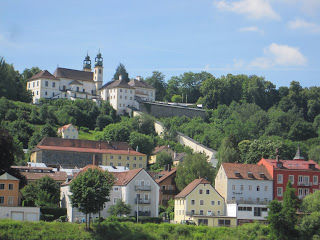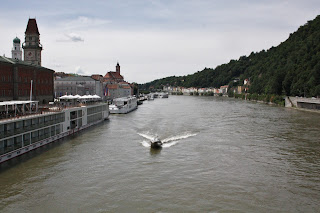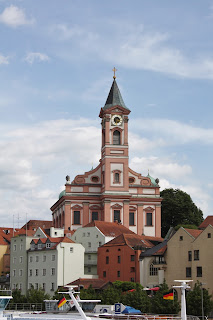Thursday, June 25, 2015
Arriving in Passau
A 19th century view
Passau is known as the city of three rivers. The Inn river flowing out of the Alps and the Ilz river flowing out of the Bavarian forests meet the Danube here. This confluence emphasizes the town's ancient and strategic location that dates back at least to the Roman era and probably even before that. It also means that flooding remains a constant threat to the city to this day. The photo below records the level of water on the Old Town Hall wall for floods from as far back as the 1500's and to more recent times. To see it more clearly just click on it. You can enlarge any picture in the blog just by clicking on it.
By the time of Charlemagne, the first Christian Emperor, Passau was the largest Catholic Diocese in the German nation as well as a cultural, political, and economic powerhouse for the entire area. The riversides all retain magnificent examples of Medieval, Renaissance, and Baroque structures.
As we approached the town the north bank catches your eye first. The Veste Niederhaus an old fortress guards the town as it has for hundreds of years. You can almost imagine small boats scuttling out from here to examine passengers, cargo, and of course exact tolls.
A bit further along on the crest of St. Joseph Mount is the massive fortress of the Bishops (Veste Oberhaus) dating back to 1219. It now houses a hostel, museums, and restaurants.
with its intricately painted window surrounds.
Looming over the background was the bulk of St. Stephan's Cathedral.


We wound our way across town and down a flowered walk that led to the banks of the Inn River
From this vantage point you could see several key sites on the south bank of the Inn. The most photogenic is the pilgrimage church of Mariahilf with 321 covered steps leading up to it. Legend has it that the pilgrim who prays hard on the way up and makes it to the top will have their appeal granted. One early ruler seeking penance is reported to have done the climb on his knees.
A bit further upstream on the South bank of Ill is the unusual cylindrical form of the Old Powder Tower (now a museum)
and then St. Michael's parish church.


My wife noted in her diary that this St. Stephan's is definitely Baroque, but it emphasizes white plaster work instead of the gaudy gold leaf of Melk Abbey. She felt that it was still plenty fancy, but was lighter and more airy--not quite as ostentacious as Melk. The retrochoir of the cathedral is actually gothic, but the interior clearly trumpets Baroque.


 |
| The ceiling paintings are gorgeous the wall carvings lush. |


And the organ loft out of this world
The organ was constructed in 1928 and has some 17,000 pipes in multiple consoles. I bought a CD of it being played and wish it could be included here.
With concert finished we headed back to the ship for a late lunch. We opted out of guided tours in the afternoon and chose just to wander a bit before our departure. Here's our ship as seen from the St. Leopold bridge over the Danube.
We looked longinly at the climb up to the Veste Oberhaus but knew that there just wasn't time to get all the way up there.
Even to reach some of the houses on the north bank looked a bit ambitious.
We settled on a Passau Potpourri. If we could stay another night this hotel, right on quayside, would have been super. Plus it also housed a Glass Museum.
Around each turn is another courtyard or fountain
Or ornate pediment
At the Neue Residence we marveled at the stucco work on the outside
and at the baroque stairway, and the colorful ceiling painting of the Olympic Gods on the inside.
Many streets sported intricate signage
And some of those signs advertised products we don't usually see in the States. The one on the right above, for instance, signified that the shop sold horsemeat.
Art Alley was one of our favorite discoveries.
It was narrow and strung with umbrellas that took on a special character when shot from below.

On the way out of town the pinkish early middle ages parish church of St. Paul wished us farewell
Regensburg here we come.
Wishing for all blue skies and no need for these.






































No comments:
Post a Comment